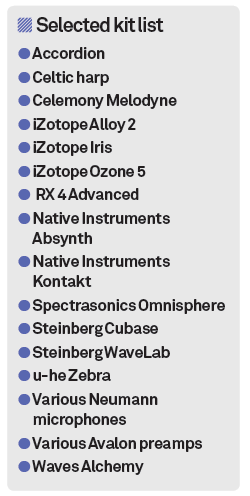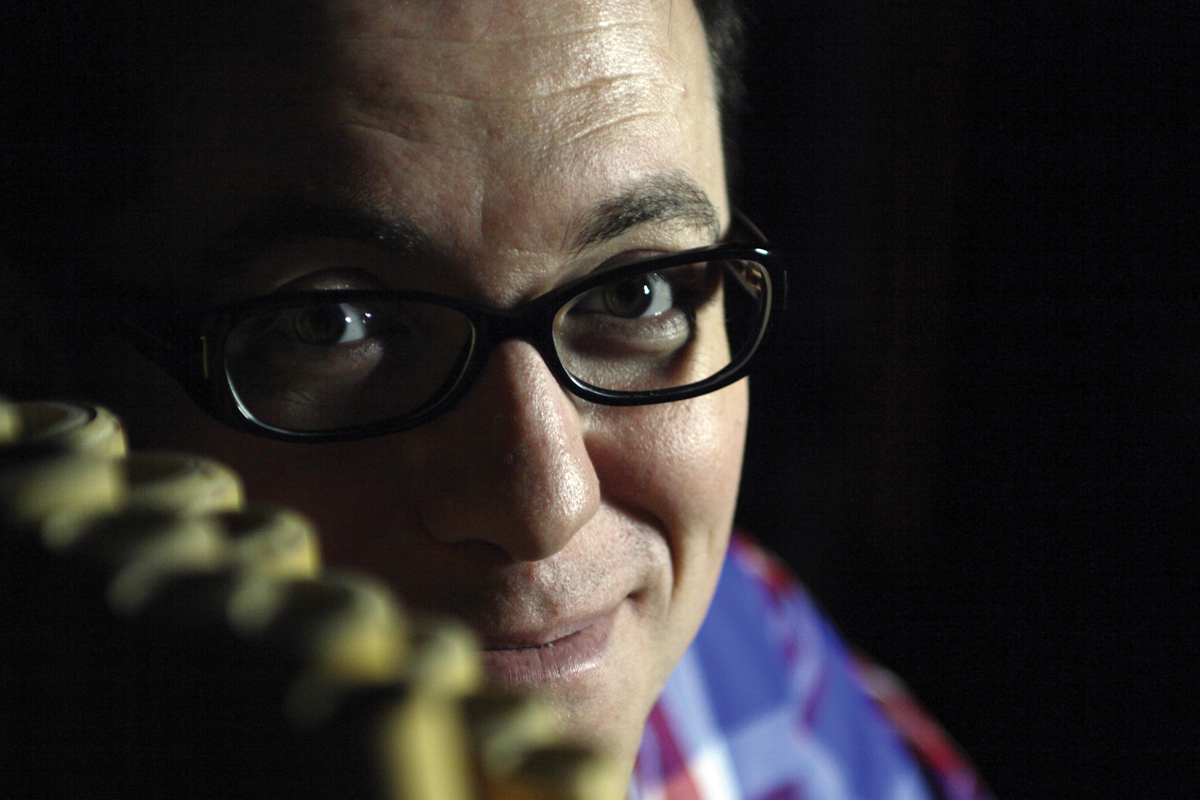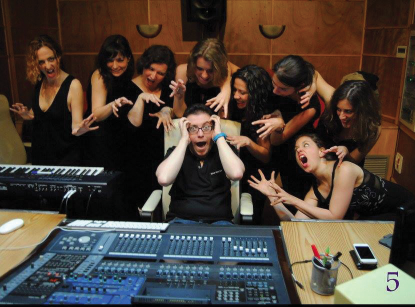Eduardo Tarilonte Interview: Monk-ey Business
Eduardo Tarilonte is producing some of the best sample libraries around, taking us on mystical journeys to places and times both real and fantastical. Andy Jones meets the man at the forefront of sound design… If you are of a certain age you might remember the pop/dance phenomenon that was Enigma. It was an act […]

Eduardo Tarilonte is producing some of the best sample libraries around, taking us on mystical journeys to places and times both real and fantastical. Andy Jones meets the man at the forefront of sound design…

If you are of a certain age you might remember the pop/dance phenomenon that was Enigma. It was an act formed by Michael Cretu that very much tapped into the chilled Ibizan vibes that were doing the rounds during the first sunset of dance music around the early-to-mid 90s.
Cretu’s Enigma embraced the post-rave feel with laid-back grooves, sensual female vocals… and monks. Gregorian chants would be his key ingredient and helped him shift millions of his debut album MCMXC a.D. in 1990, and between that and a half-dozen follow-ups he racked up 100 Platinum sales awards across the world. Not bad for some beats and chants.

Fast forward to 2014 and monks, fantasy and mystery are very much back in vogue, certainly in the world of sample libraries. This is, in part of course, down to the success of the Lord of the Rings and Hobbit trilogies but it’s also down to one Eduardo Tarilonte and his Best Service libraries.
MusicTech was one of the first to pile plaudits on Tarilonte’s early Forest Kingdom series, but it’s been his vocal fantasy series that has put him on the sound designing map. Precision vocal recordings have made these essential packages for anyone wanting original soundscapes, whispering, chanting, spoken word and phrases within a wide variety of genres.

He’s covered everything from elves (Shevannai) to the Renaissance (Altus) while Mystica offers bewitching female vocals that act as a counterpoint to the Gregorian chanting from Cantus.
And that Gregorian chanting brings us full circle back to Enigma, because so good is Cantus that Mr. Michael Cretu himself has endorsed it. And so good are the rest of Tarilonte’s collections that we are endorsing him with this coveted MusicTech Industry Guru interview…

MusicTech: How did you get into recording in the first place?
Eduardo Tarilonte: I started my career as a musician, although my dream was being a soundtrack composer. When I was a child I started playing accordion but I got hooked on synthesizers the first time I listened to them. I remember during my childhood playing lots of soundtracks, TV themes and Jean Michel Jarre music on a Technics organ.
I still remember the day that I could afford my first Korg synth – it took me almost two years to pay for it! But I was then composing every single day, so when I turned 18 I decided to dedicate my life to music and fight for my dream of being a composer.
Over the next 14 years I struggled to make a living from music, playing in many bands, mainly folk and Celtic and rock, while I composed music for some TV companies. Despite all the troubles, which were a lot, I never gave up.
Besides synths there was something I loved even more: virtual instruments. I am 41, so when I started, the idea of making a great mock-up just with a computer was almost a dream, but I had the chance to see how that world evolved. Of course, I never thought I could end up being a sample library developer! In 2004 I composed a track using a library from Bela D Media. I was surprised when they contacted me asking if they could use it as an official demo. Of course I said yes!
Some months later, Frank Belardino, the owner of the company, asked me if I would like to be a sample library developer. I was shocked, but didn’t think twice, since virtual instruments were fascinating to me. I started to think what I could do to create a great sample library. Since I was playing in Celtic groups for a long time, I decided to make a Celtic sample library dedicated to winds: Celtic Wind.
It was released in 2006 and was one of the first ones to use the advantages of the new Kontakt 2 scripting. The success of it took me by surprise. I think one of the secrets was that I carefully recorded all of the noises of the instruments to add them later in a controllable way. I also focused on the playability: one instrument with all the articulations in a single patch.
That’s how I started, and of course I got addicted to developing since the very first second. After that more libraries were released with great reviews. In 2009 I contacted Best Service and, since then, we have had a great business relationship and an even better friendship.
MT: Do you have a recording philosophy, something that you personally bring to the studio?
ET: It’s clear that music is about emotions, and the same is applied to recording and producing. For me it is not so important having great gear but more about what you record or produce in terms of transmitting emotions or the inner essence.

MT: Tell us a little about your studio – main components, how it came together…
ET: I have a room at home where I do all of the post-production for my sample libraries. For recording sessions I always hire a professional recording studio. I am very picky when it come to the sound and not every place is good to record.
Since I record many different musicians I tend to hire a recording studio close to where the players live if they cannot come to the city where I am.
My favourite gear for recording is simple: Neumann mics and Avalon preamps. For editing, I use WaveLab to cut and edit samples and Cubase for my demos. I also use Melodyne for extra tuning.
MT: How would a track typically start structure-wise and then progress?
ET: It depends. I usually start with some string pads to create the general harmonic idea. After that I start to elaborate a melody or some arrangements.
If I like the idea then I start to see which instruments fit better to the arrangements. I think that using the right sound is important to get the right feeling and get inspired. That’s why sample libraries are so great to compose with. Listening to the exact instrument sound while composing is magic. That was just a dream 15 years ago.
MT: What are your favourite sound-generating studio tools?
ET: I play accordion, Celtic harp and keyboards. No guitars. I am not a huge fan of real synths as I prefer virtual instruments for that. Everything in my studio is virtual. I just record real things to sample them. My favourite software tools for sound are Kontakt, Absynth, Zebra, Alchemy and Omnisphere. And as I said before, I couldn’t live without Cubase and WaveLab.
MT: And what plug-ins or outboard do you find most creative?
ET: For plug-ins I love iZotope. I use RX 4 Advanced, Ozone 5, Alloy 2 and Iris. All these are very versatile, easy to use and completely reliable in terms of performance.

MT: What advice have you picked up from working in the industry?
ET: I know it sounds like a cliché, but ‘keeping on’ is the best advice ever. In my case, struggling for 15 years is a pretty good example of that. It’s not easy, but this is not a short-term business – you need many years to improve, get contacts, etc.
Another important point is to be yourself. I have never been interested in doing the same things others do. It’s okay – we all have our likes – but if you want to be good at something you must be yourself.
No-one will do what you do better than you. If you emulate others then you will never be able to express what you have inside, and music is all about that. Over the business or any other thing, making music, producing, developing sample libraries is about expressing your inner world for others to enjoy.

MT: And advice from all your years working in the studio?
ET: I’ve learned that if you want to do something exactly as you want, you have to do it by yourself. You cannot request others to do it because they will do it their way, not your way, even if you tell them exactly how to do it.
I am very picky about how I want things to be recorded, not only in terms of sound but also in terms of how everything is played – that’s probably the most important point. Also, once you get in the studio you must really concentrate to get the best out of the recording session. If something fails, you will have to come back to the studio and hire the musicians again.
The Best Service Connection
MT: How did you get involved with the Best Service vocal collections?
ET: As I explained I started my career as a composer, but soon I realised that virtual instruments were even more appealing. In 2009 I started to work with Best Service. That was my best decision so far as not only did I get perfect business partners but also best friends. A big part of my success is thanks to Best Service.
Regarding the vocal libraries they have always been in my mind since the beginning, but there is no doubt that vocals are the hardest thing to sample. You can tweak any sample from any instrument and it still sounds good, but if you tweak a vocal sample even slightly it will sound fake…
One of the first things I wanted to do when I started developing vocal libraries was a playable library: something easy to use in a single patch like the other instruments I did before. So, a mix between true legato and words and syllables was a must.
That’s how the ‘auto vowel’ idea came up. I wanted to be able to play words and syllables and blend them with the true legato articulation automatically. So I recorded true legato in five vowels – there is no playable vocal library without a good true legato. The ‘auto vowel’ feature looks like something simple and logical once you play it, but no one had done it before.
Another decision I had to make was choosing to be able to write and sing almost everything or not. In my opinion a library with a full word builder will never sound good even with the technological tools and advancements we have nowadays, so I decided to record quite a few words that could be split later to create a lot of sonic possibilities.
I prefer to create a real feeling of a spoken language without any meaning rather than being able to write everything and having it sound fake.
Speaking about Cantus and Mystica, one of my main goals was recording the choirs without filtering the samples. I wanted the real sound.

Many choir libraries sound great, but you can notice that some have been heavily filtered to avoid resonance issues. That removes the soul from them and doesn’t allow you to use them in an out-of-the-box context.
It has been a huge challenge, but since I love challenges I will still release more vocal libraries. I have learned a lot since Shevannai was released.
MT: Where did the idea and inspiration come from to produce the range in the first place?
ET: Shevannai was my first vocal library and its inspiration came from The Lord of the Rings. When I listened to the track Twilight and Shadow featuring Renée Fleming I was so impressed that I said to myself: ‘I must sample a vocal library able to transmit such deep feelings.’
That was in 2009 and Shevannai was released in 2013. That shows that I take a lot of care to record exactly what I want. It took me a long time to find the right singer.
After Shevannai, the dream of recording a Gregorian choir came true. My main inspiration has always been to create emotional yet cinematic sample libraries.